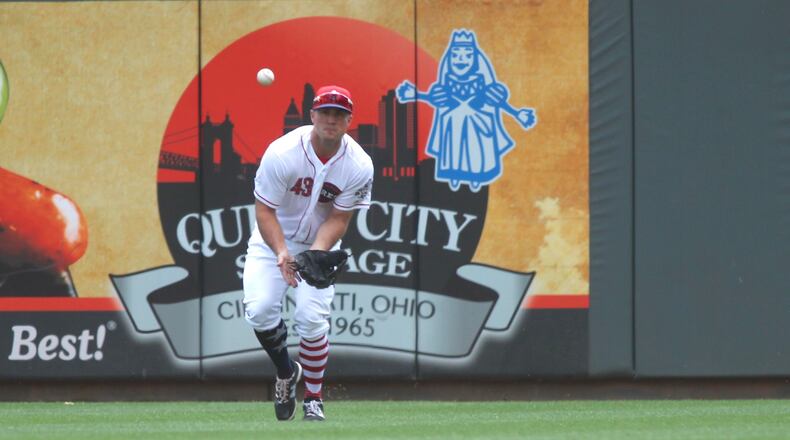»ASK HAL: Any chance Brandon Phillips returns?
It is none of those. It is a cheat sheet, a legal cheat sheet.
The last time I used a cheat sheet, my economics professor seized it and tossed it and my test paper into the trash and gave me an ‘F.’
But this is entirely legal and not only sanctioned by the team but the cheat sheets are distributed to all the outfielders.
The Reds coaching staff, using a heavy dose of analytics, fills out the cards, listing tendencies of the hitters and instructing the outfielders where to stand to most likely catch a line drive.
»RELATED: Reds have as many errors as hits in loss to Pirates
It really isn’t something new. In the past, managers and coaches would stick their heads out of the dugout and wave towels at the outfielders, directing them where to move and where to stand.
The cards make it much easier. And it is new to the Reds this year, although other teams have used it the past couple of seasons.
“It just improves the communication,” said Reds manager David Bell. “In the past, for years and years, it has been the coach telling the outfielders where to play with a towel or a wave. And that’s quite the distance.
“It makes sense,” he added. “You can go into a game knowing where to play, based on our starting pitcher against their hitters. But as the pitching changes you have a lot of keep track of in your mind.
»RELATED: Jose Iglesais and “Baby Shark”
“In the end, we want our players to use their instincts and respond to situations, but when you can have that additional information it is helpful,” said Bell.
“This (shifting) has been going on for a long, long time, figuring out where to play and where this guy or that guy is going to hit,” Bell added. “We do have more information now than we had in the past, but it is still the player making those adjustments. We want them to believe it and trust that.
“But also as part of their decision-making process we can provide more information and it is easier to keep track of it on a card than always trying to communicate between the coaches and the player,” he said.
The Reds are doing something else not seen in Great American Ball Park or even its predecessor, Riverfront Stadium (Cinergy Field).
There are times when the Reds will use a four-man outfield. They did it in spring training with second baseman Jose Peraza playing right center in the four-man formation.
“We will use the four-man outfielder, depending on the hitter/pitcher match-up and the situation,” said Bell. “It could be Peraza, but it will depend on the situation. So, yes, I would anticipate it happening.
IT WAS IN THE mid-30s at 1:10 when Sunday afternoon's game began, not even close to the colest temperature at game-time in GABP.
It was 30 degrees at game time on April 7, 2007, also against the Pittsburgy Pirates and the coldest temperature ever at game time in GABP.
Bell was asked if he had any advice to his players to ward off the chills and tingling digits.
“Don’t talk about it, don’t think about it,” he said. “Stay focused. It is a challenge to do that but you have to do your best to not think about it. The more you talk about it and think about it, the worse it is. The sun is out and it a beautiful day.”
About the Author
